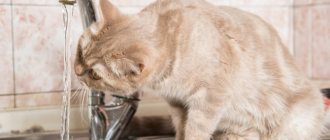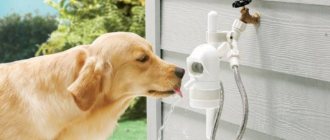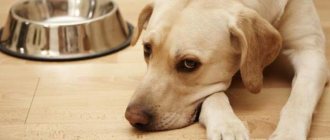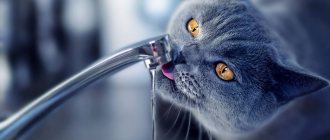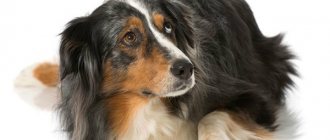Physiological characteristics of different dogs
The volume of water consumed is influenced by physiology and certain factors:
- breed characteristics;
- dimensions, weight and constitution;
- coat length;
- number of complete years;
- metabolic rate;
- activity and stress.
Important! Pekingese, pug and toy terriers require less water than a shepherd or any large dog.
In long-haired animals, increased thirst is associated with additional heating; they also begin to urinate more often - there is nowhere else to put the excess fluid.
Thirst is common in pregnant women
Pregnant dogs
Gestation affects hormonal balance and other changes in physiology. Normal fetal development requires more fluid; before giving birth, animals drink in unlimited quantities. Lactation also increases the amount of water needed to produce milk.
Important! With a false pregnancy, a similar picture is observed. The problem is related to the similarity of symptoms, reminiscent of standard pregnancy.
During heat
The dog often drinks water during menstruation. Hormonal levels change, the pet becomes more restless and active, and metabolism accelerates. Females begin to pee more often. These factors become the reasons why many animals in heat are unable to drink.
Standards for puppies and old dogs
When calculating needs, age characteristics are taken into account. Puppies require 100 ml of fluid per kilogram of weight, older dogs less. Veterinarians emphasize the following features:
- young animals are characterized by activity and accelerated metabolism;
- puppies are more likely to experience thirst than mature individuals;
- older animals drink more than adults.
Important! In an aged body, the kidneys work worse, which leads to an increase in the frequency of fluid intake.
The puppy wants to drink more often
After surgery and anesthesia
The postoperative period and medications (antibiotics, painkillers) provoke an increased desire to drink. Any surgical intervention is considered stress for the body, and water helps it recover faster.
Important! Immediately after surgery, liquid is given in minimal portions so as not to provoke a gag reflex.
This approach reduces the load on the cardiovascular and urinary departments.
How much water should a dog drink per day?
How much water should a dog drink per day? Unless you have a medical condition, there is a balance between water gain and loss and you will need 70ml of water per day per kg of body weight .
At the point when water loss increases due to a certain pathology, the dog will need to take in more water than usual, this change is called polydipsia (which we discussed above). Polydipsia is usually accompanied by polyuria (dogs tend to walk small) and may be accompanied by other clinical signs.
Symptoms and reasons why your dog starts drinking a lot of water
The appearance of unreasonable thirst requires careful observation of the animal. There is a list of additional clinical manifestations indicating a malfunction in the canine body, which is presented:
- nausea and vomiting;
- sudden loss of body weight;
- refusal to eat or a sharp increase in appetite;
- blanching or bluish tint of visible mucous membranes;
- apathy, depression, refusal to walk and play;
- excessively frequent urination;
- indigestion with diarrhea;
- sudden excitement;
- secretion from the nasal passages and eyes;
- viscous and thick saliva;
- breathing problems;
- violation of orientation in space;
- high or low temperature;
- convulsive syndrome, spasms and fainting.
Indifference and refusal to eat are additional reasons for concern.
The reason why a dog drinks a lot of water can be any of the following:
- malfunction of internal organs and systems;
- poisoning;
- viral and parasitic infections;
- helminthiases;
- diabetes of various types;
- pyometra, etc.
Important! The occurrence of concomitant symptoms requires a visit to the veterinary clinic.
It is better not to self-medicate, especially when the animal has difficulty breathing or begins to vomit violently.
What to do?
So, you've noticed that your baby or adult dog is constantly hanging around the drinking bowl. First, measure the amount of liquid to confirm your guess. To do this, you need to know exactly the volume of the bowl, fill it regularly and monitor your pet’s actions.
Pay attention to the animal’s diet: does it have enough protein? Be sure to exclude salt and sugar in any form from your furry diet. Sometimes things happen when you don't see. For example, the children were fed a piece of sausage or candy.
Analyze the situation. See how long this behavior continues, whether there are any additional factors or trivial reasons. For example, it’s stuffy outside or you recently changed the type of food. Just make sure your puppy has a large container to drink. In summer weather, arrange the bed in a cool, shaded place. In winter, purchase a humidifier.
We advise you to read: Is it possible to wash a dog with soap?
It is very important to assess the general condition of your furry friend: is he active? Is he eating well? How often does he pee? Have there been any sudden changes in your health? If you notice any other problems, do not delay visiting the veterinarian. First of all, take your temperature.
Conditions that are accompanied by polydipsia can be very dangerous. If the furry one drinks a lot due to vomiting and diarrhea with blood, fever, and very frequent urination, then help should be immediate.
At your doctor's appointment, accurately describe all your observations and answer questions. It will be necessary to take tests and conduct detailed examinations:
- Ultrasound
- blood and urine tests;
- measure pressure;
- hormone tests;
- ECG;
- X-ray.
ATTENTION: until the doctor determines the cause and gives recommendations, do not artificially limit your pet’s drinking.
Try not to worry too much. An owner's anxiety is not good for anyone.
Diseases accompanied by increased thirst
The occurrence of thirst in a dog due to illness occurs less frequently than under physiological conditions. Each pathology has its own clinical signs, which veterinarians use to determine the source of the ailment.
Colds and infectious diseases
Why can’t you make a diagnosis yourself? The cause of the pathology can be any viruses and bacteria. Veterinary care is required for fever, diarrhea, vomiting, and changes in the natural shade of the skin and mucous membranes.
Piroplasmosis
The disease is provoked by the bite of an ixodid tick and causes:
- severe apathetic state;
- refusal to eat - the animal begins to lose weight;
- the appearance of blood particles in the urine.
Important! The dog needs to be shown to a veterinarian who will provide supportive therapy.
Spinal injury
Breeds with elongated bodies suffer from problems with pinched nerve endings. This list includes basset hounds, dachshunds, etc. If, due to frequent urination, a shaky and uncertain gait appears, then the animal should be shown to a specialist.
Obesity in diabetes causes increased thirst
Diabetes mellitus or diabetes insipidus
The symptoms of the pathological condition depend on the type of diabetes that has developed:
- With sugar, animals will experience pathological thirst and often go to the toilet. Rapid weight gain is associated with increased appetite; they consume everything. The pet vomits, may feel nauseous, and there is a loss of visual acuity due to cataracts.
- With sugar insipidus, a drop in temperature, disorders of the gastrointestinal tract, and decreased appetite are noted. Animals lose weight, they develop problems with skin condition and blood pressure levels.
Important! A dog constantly and often drinks water with any of these forms of diabetes.
Cushing's disease
Increased amounts of cortisol lead to the following symptoms:
- constant feeling of hunger;
- sagging abdomen;
- noisy breathing;
- obesity.
Important! An insatiable desire to drink and the above symptoms require contacting a veterinary hospital.
Signs of Cushing's syndrome
Psychogenic polydipsia
The problem is related to psychological problems. The pet is afraid of not getting enough to drink and tries to get drunk for future use. The culprit of psychogenic polydipsia is some unpleasant event: prolonged sitting locked up or on a chain, without access to water.
Pyometra
Inflammation of the uterus resembles the symptoms of bacterial or viral pathologies. Pyometra leads to nausea, vomiting, diarrhea, and apathy. Females suffer from temperature fluctuations and abdominal pain.
Stomach ulcer
Ulceration of the mucous membrane or open wound surface causes fluid loss. To replenish it, the pet begins to regularly lap up water, which provokes even greater thirst due to profuse vomiting.
Gastritis or ulcer is another reason for great thirst
Poisoning
Poor health is associated with toxic substances or food of dubious quality. Serious intoxication is accompanied by:
- apathy or causeless agitation;
- accelerated contraction of the heart - determined by the pulse;
- increased temperature;
- convulsive syndrome;
- profuse salivation;
- diarrhea;
- change in the shade of the mucous membrane - from whitish to purple-red.
Important! Mild poisoning causes one-time vomiting, diarrhea, nausea and desire to drink.
Diabetes mellitus or its non-sugar form
Diabetes is a chronic metabolic disorder with high levels of sugar in the body. There is a disease called diabetes insipidus, which is associated with an imbalance of water-salt balance. It is similar in symptoms to regular diabetes. You can begin to suspect problems based on the following signs:
- the dog drinks a lot, but does not get drunk, the mucous membrane is not moisturized; with insipidus, he can drink up to 15 liters per day;
- he wants to go to the toilet more often, he can’t wait to go for a walk;
- urine becomes lighter;
- appetite increases, but the animal does not gain weight;
- an unpleasant sweet or rotten odor appears from the mouth;
- eyes become cloudy;
- numbness of paws, unsteady gait;
- wounds and scratches take a long time to heal, the fur becomes dull, and the animal itches constantly.
We advise you to read: When should you give your dog (puppy) a deworming tablet?
Polydipsia occurs because nutrients are continually lost from the body through urine and unprocessed glucose. The balance needs to be restored.
How to Make Sure Your Dog Gets Enough Water
Measuring the amount of fluid consumed is carried out according to the usual scheme:
- The volume of the bowl is measured with a measuring cup;
- water is poured into it;
- measure flow for 24 hours.
Important! During the procedure, you need to take into account the amount of moisture received along with food or natural products, how much the animal ate per day. Based on the general data, you can get the answer.
Quantity is measured using a measuring cup
Water consumption rate for dogs
An animal may have a single attack of thirst, for example, when the room is too hot, the dog begins to drink heavily.
This is quite acceptable , as the body is trying to cool down somehow. But if the animal begins to drink excessively constantly, the owner must take a closer look at the accompanying symptoms. Perhaps the reason is pathology.
Before deciding whether your dog drinks a lot, you need to know how much he should drink. It all depends on its weight: for each kg no more than 100 ml. If a dog weighs 5–10 kg, then it should drink no more than 0.5–1.0 liters per day. In this case, it is necessary to take into account not only clean water, but also all liquid dishes if the animal is on a natural diet.
A dog up to 10 kilograms drinks no more than a liter per day.
How to measure?
Before giving water to your dog, you need to measure its volume.
To determine how much your pet drinks, you need to take measurements.
When pouring water into a bowl, first measure its volume. When feeding, they also record how many ml of liquid meals were eaten per day. The readings are summed up and after that it is only possible to conclude whether the dog drinks a lot or whether this is normal for its weight. Don't forget to measure the water as you add it throughout the day.
What to do if your dog drinks a lot of water and urinates a lot
Polydipsia can be of physiological or pathological origin. If you have increased thirst, you need to find out the source of the behavior and measure the amount of liquid you drink per day. The owner should:
- review your usual diet - remove sweets, salty and other unhealthy foods;
- stop feeding the animal industrial biscuits included in the “economy class” category;
- increase your intake of protein foods as recommended by your doctor.
Important! Sometimes polydipsia occurs as a response to a change in the daily menu, when switching from natural to ready-made food. In this case, there is no problem - dry ready-made diets require more liquid.
Treatment and assistance for your pet
Dog food should not be salty.
How can you help your dog if he drinks too much water? Here are the basic recommendations to help novice dog breeders:
- Checking dog food for salt . If foods are oversalted, you should change your diet and temporarily eliminate salt completely.
- By increasing the amount of protein foods in the menu , you can reduce water consumption.
- If thirst is caused by switching to dry food , just put a large bowl of water and periodically add liquid to it.
- If the owner suspects a dog has pyometra , it is necessary to contact a veterinarian. He will prescribe blood tests: general and biochemical, then send the animal for an ultrasound. Depending on the results obtained, treatment will be prescribed. In severe cases, this will be surgery with removal of the uterus and ovaries. Sometimes conservative treatment is prescribed. This will include antibiotic therapy, as well as the use of hormonal agents that affect the contraction of the uterus and the removal of any contents from it.
- Diabetes in animals is considered incurable , but the use of special medications can improve the condition and prolong the life of the pet. If your pet has diabetes, a diet will be recommended and insulin will be prescribed. The veterinarian will select the dose. It will depend on the constitutional characteristics of the dog and its physical activity. As for nutrition, it is best to switch the animal to ready-made food for diabetics. This will make it easier to control the nutrition process. Feed should be chosen only of high quality. If the doctor prescribes insulin, your pet will have to inject it at the same time every day. The doctor will select the dosage and tell you whether it is better to inject into the withers or chest. Special syringes are purchased at the pharmacy. You will also need to have a portable glucometer on hand to monitor your glucose levels. Sometimes, after taking insulin, an animal experiences an excessive drop in glucose levels, which can lead to the development of a hypoglycemic coma and can result in the death of the animal. If the level on the glucometer drops to 3 mmol/l, you should give the dog something sweet. For example, natural honey or dilute sugar in water and feed the animal with this syrup.
- If you have cystitis, give your dog as much water as possible ; you can brew bearberry and let your pet drink this decoction. Treatment with antibiotics is mandatory. In a veterinary clinic, the bladder is washed with disinfecting solutions. Suitable for this purpose: furatsilin, potassium permanganate, penicillin. In case of an infectious process, urosulfan, furadonin are prescribed, and if Pseudomonas aeruginosa is detected, gonocrine is prescribed. Cystenal helps relieve spasms and soreness. It is dripped onto sugar and given to the pet to eat.
Tips for dog owners: what to do at home
Self-help includes:
- in moving the booth to the shade - for individuals living on the street;
- in compliance with air humidity standards and regular ventilation of premises;
- in refusing to use table scraps as food;
- in feeding diets of the “premium”, “super-premium”, “holistic” classes.
Pathological conditions cannot be cured on your own; your pet needs a doctor and adequate treatment. In some cases, the life of a four-legged animal depends on the timeliness of going to the hospital. Ignoring increased thirst can cause a sad ending, especially with the development of diabetes, pathologies of the kidneys, liver, and gastrointestinal tract.
Norm and deviations
If an animal does not drink enough fluid, it causes dehydration and can result in death.
The opposite situation is no less dangerous. When a dog drinks a lot of water, it complicates the functioning of vital organs and contributes to the development of severe pathologies .
What is polydipsia
If a dog has increased thirst, doctors diagnose polydipsia, the main cause of which lies in physiological factors. Sometimes psychogenic polydipsia occurs, when the animal has an obsessive desire to drink.
Owners should control the amount of water their pet drinks.
There are norms for daily fluid intake. If the indicator is exceeded, excess moisture accumulates in the tissues (this problem is called overhydration), which leads to compensatory polyuria.
Frequent urination puts a strain on the kidneys.
A similar situation is caused by a disruption in the functioning of the hypothalamus and pituitary gland, which produce a hormone that regulates hydrobalance in the tissues of the body. When renal tubular cells stop responding to ADH, polydipsia develops.
Features of prevention
The genetic predisposition of some dogs to diabetes insipidus and other metabolic and kidney pathologies cannot be eliminated. It is possible to prevent inflammatory kidney disease in dogs - glomerulonephritis, pyelonephritis:
- proper feeding;
- avoid hypothermia;
- use medications only as prescribed by a veterinarian;
- prevent exposure to household and other poisons;
- promptly treat diseases of the urinary system.
All systems in an animal's body are connected. Therefore, cardiac, respiratory or liver failure often leads to a deterioration in the functioning of the excretory system - the dog urinates on itself and drinks much more. Preventing diseases of other organs will save your pet from kidney damage. Vaccinations and treatments against parasites must be carried out according to the plan. All pathologies must be eliminated at an early stage, and after treatment a course of rehabilitation must be carried out.
Proper feeding is of great importance for the health of your pet. Excess protein and salts in the feed leads to disruption of the nephrons, and filtration capacity decreases. Feeding must be organized taking into account the age, sex and weight of the animal. Proper care will help you get rid of most pathological conditions.
